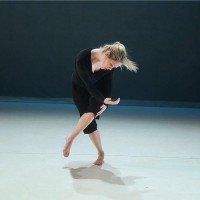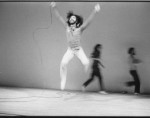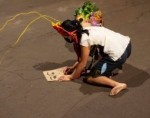
Paradoxical Transmissions: The Dance of Darkness in Words
Jack and the Beanstalk.
Reaching towards the sky
Slumber
Pegasus
A scarf around your neck
Mont Blanc
A lace curtain
Repentance
Finally, the stretched out hand of
Europe.
––Tatsumi Hijikata
I refer to this excerpt of Tatsumi Hijikata’s butoh notation after I finish reading the New York Butoh Institute’s first published book Butoh: Cradling Empty Space by Vangeline. I contemplate how I myself could transform from slumber to Pegasus. “Image memos,” like the poem above, are examples of visualization techniques that butoh practitioners use to evoke a unique collage of body memories that stimulate surprising movement responses—one of the signature characteristics of the dance form.
Butoh: Cradling Empty Space is reminiscent of an “image memo.” The book reads like an intricate quilt, or decoupage; Vangeline carefully connects theory and practice to illustrate the technical complexities and multidimensional sociocultural landscape of butoh. Vangeline’s analysis of butoh—an avant-garde “dance of darkness”—layers together a sweeping amount of research approaches. Equal parts historical account, feminist critique, critical race theory, and scientific and phenomenological study, this is not just a how-to handbook (although those practical parts are present too). Butoh originated in 1950’s and 60’s Japan as a reaction to the horrors of the Hiroshima and Nagasaki bombings by the U.S., and has experienced a widespread process of globalization and appropriation since its birth.
Vangeline grapples with the indescribability of butoh, which reflects a larger question about the codification and transmission of its practices from one generation to another. She openly acknowledges the complexity in writing about butoh—likely because to try and completely codify butoh is to take away from its essence. On the other hand, she says that some level of circumscription is necessary to preserve and advance the livelihood of the dance style. When people with a cis-patriarchal, white, westernized lens watch butoh, they often mistake the amorphousness of the movement vocabulary and bodily contortion for ancient mysticism.
Vangeline writes how the ubiquitous inner processes of butoh are difficult for an audience to perceive. Attitudes rooted in Eastern philosophy to concepts that influence butoh like self, darkness, and chaos, make butoh feel even more abstract, especially for Western audiences. Vangeline roots the artform in extensive research and theoretical inquiry to dispel the ambiguity around its practice, while preserving its spirit of transformation.
The research’s rigor is especially apparent in the opening chapters of the book, which focus heavily on the history of butoh’s inception as an artform that defines Japanese identity as distinct from Western culture. Early butoh creators appropriated elements of corporeal miming techniques and surrealism, ideas like “waiting and listening,” to reflect radically new interpretations of Japanese art and theater.
Like so many other dance traditions, butoh’s narrative canon decidedly omits the contributions of women and places two men—Tatsumi Hijikata and Kazuo Ohno—in near god-like positions as the sole originators of the dance form. Vangeline gives a more comprehensive picture of butoh’s origin story that acknowledges Hijikata and Ohno’s contributions but also includes those of women like Yoko Ashikawa. Later, she continues her exploration of women as practitioners, notably in parts of subsequent chapters regarding the power dynamics in the teaching practices of butoh like the traditional “master/student” relationship, where the majority of butoh masters are men.
Vangeline draws on her extensive background in trauma-informed teaching approaches in this section of the book to highlight the effects of stress responses on the nervous system in butoh and its unconventional and sometimes extreme approaches to pushing physical and psychological limits. The candidness of the “challenges” chapters shows that butoh wrestles with what Vangeline calls a “constant tug of war between tradition and innovation.”
Further still, is the question of Japanese identity in relation to butoh, especially regarding the historical and contemporary feedback loop of cultural appropriation that butoh has with the West. Butoh’s globalization happened because of an intense curiosity (bordering on fetishization) for the artform outside of Japan—and how even definitions of cultural embodiment are hard to codify when talking about butoh. For Vangeline, paradox seems to be the conclusion to a lot of these questions.
Uniquely, much of Butoh: Cradling Empty Space is dedicated to the science behind the inner experience of butoh practitioners. Vangeline expertly navigates through concepts like action potential, information processing, and neuroplasticity as they relate specifically to butoh. At first, these ideas might seem daunting to comprehend, but Vangeline’s explanations make room for an approachable level of understanding, especially through her use of data tables, graphic charts, and photos.
In the final chapters, she expands on the scientific foundations she lays in the middle chapters, to grapple with the paradoxical complexities that come with defining butoh. This is an important perspective to include in the book; a unifying aspect of butoh, which in so many ways cannot be singularly defined.
Vangeline includes specific exercises and techniques in the science focused chapters. Concrete visual examples help synthesize the information more practically. The section on how butoh dancers train to modify the focus of their eyes to better tap into their inner experience was especially interesting. The photos that Vangeline includes of butoh dancers with eyes softly focused or even rolled back into the head demonstrate the physical command practitioners must have over their body. Another common technique is dépaysement, where dancers learn to provoke “small involuntary movement” by redirecting or interrupting their action at precise moments. Vangeline claims most audiences (which are overwhelmingly non-Japanese) don’t pick up on the heightened kinesthetic awareness, level of control, or nuance of motor skills required during a performance.
Vangeline claims butoh is appealing to so many because these sensory experiences are universally accessible to practitioners of all backgrounds. I can easily feel the things she describes as I read; the way my eyes are focused, or the comfortable familiarity of the fetal position. Even for those without a dance background, the book touches on ideas—kinesthetic phenomena, body memories, sensory responses—that are fundamental human experiences. Butoh: Cradling Empty Space doesn’t conclude with a clear picture of butoh. Instead, it ends with a collage of ideas that, with a relaxed gaze, begins to take shape, only to transform again.
Vangeline, Butoh: Cradling Empty Space (Brooklyn, New York: New York Butoh Institute 2021)
By Leslie Bush
February 23, 2021








